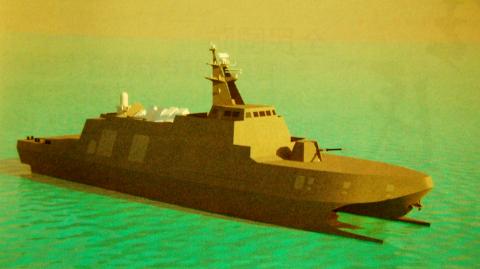Despite hitting a snag in a recent bidding process, the navy is proceeding with the development of a stealth 500-tonne fast attack missile boat that is already being hailed as Taiwan’s “carrier killer.”
Plans for the indigenous development of the 500-tonne corvette were first made public in 2009. In April the following year, Deputy Minister of National Defense Lin Yu-pao (林於豹) told the legislature that design work as part of the Hsun Hai (迅海, “Swift Sea”) program was completed and that bidding would be held this year.
The legislature last year passed a NT$24.98 billion (US$853.4 million) budget to build between seven and 11 corvettes, with delivery scheduled for 2014. The boats are reportedly expected to remain in service for 25 years.

Image provided courtesy of the Republic of China Navy
However, the process hit an obstacle last month, when only two small firms, Ching Fu Shipbuilding Co and Lung Teh Shipbuilding Co, participated in the bid for construction of the Swift Sea prototypes. China Shipbuilding Corp, Taiwan (CSBC), the nation’s largest shipbuilder, did not participate in the March 26 bid, causing it to fail, the Chinese-language Asia-Pacific Defense Magazine reported in its latest issue.
A CSBC official said the firm decided not to participate in the bid because several technological requirements for the project had yet to be confirmed by the ministry.
Once those issues have been cleared up, CSBC will participate in the bid, the official said, adding that the company was very keen on winning the contract.
The corvettes will come equipped with eight Hsiung Feng II (HF-2) and Hsiung Feng III (HF-3) anti-ship missiles, as well as a 76mm rapid-fire bow gun. The catamaran-style design, reports said, may have been inspired by the 220-tonne Houbei-class Type 022 catamaran recently deployed by China’s People’s Liberation Army Navy (PLAN).
Analysts are saying the central cross-linked structure of the Swift Sea corvette will provide high stability, adding that its 30 knot (55.5kph) speed will also be an asset. Special attention has reportedly been paid to the stealth design for the hull and main gun turret, which will use radar refractive materials
The program is seen as the logical follow-up to the development of the Kuang Hua VI (KH-6) fast-attack boats in service in the navy since 2010. In all, 31 of the CSBC-made, 170-tonne KH-6s, divided into three squadrons and which carry four HF-2s each, are active in the navy. Earlier this year, critics of the small attack craft said its light displacement and top-heavy design undermined its stability at sea, especially during unfavorable weather conditions.
James Holmes of the US Naval War College told the Taipei Times at the time that the KH-6 was probably only a transitional platform until something better was introduced.
Amid growing focus on the indigenous development of weapons systems, Taiwan appears to be slowly emphasizing an asymmetrical approach to countering the Chinese military, with less reliance on heavy — and expensive — platforms and more on speed, stealth and evasiveness, analysts say.
Taiwanese defense analysts say the principal role of the new corvettes in coastal defense will be to target any carrier battle group deployed by the PLAN in nearby waters.
China’s first aircraft carrier, the refurbished former Soviet Varyag, is expected to enter service in August this year. Two or three additional carriers are expected to be built by Chinese shipyards by 2020.

US climber Alex Honnold is to attempt to scale Taipei 101 without a rope and harness in a live Netflix special on Jan. 24, the streaming platform announced on Wednesday. Accounting for the time difference, the two-hour broadcast of Honnold’s climb, called Skyscraper Live, is to air on Jan. 23 in the US, Netflix said in a statement. Honnold, 40, was the first person ever to free solo climb the 900m El Capitan rock formation in Yosemite National Park — a feat that was recorded and later made into the 2018 documentary film Free Solo. Netflix previewed Skyscraper Live in October, after videos

Starting on Jan. 1, YouBike riders must have insurance to use the service, and a six-month trial of NT$5 coupons under certain conditions would be implemented to balance bike shortages, a joint statement from transportation departments across Taipei, New Taipei City and Taoyuan announced yesterday. The rental bike system operator said that coupons would be offered to riders to rent bikes from full stations, for riders who take out an electric-assisted bike from a full station, and for riders who return a bike to an empty station. All riders with YouBike accounts are automatically eligible for the program, and each membership account

NUMBERS IMBALANCE: More than 4 million Taiwanese have visited China this year, while only about half a million Chinese have visited here Beijing has yet to respond to Taiwan’s requests for negotiation over matters related to the recovery of cross-strait tourism, the Tourism Administration said yesterday. Taiwan’s tourism authority issued the statement after Chinese-language daily the China Times reported yesterday that the government’s policy of banning group tours to China does not stop Taiwanese from visiting the country. As of October, more than 4.2 million had traveled to China this year, exceeding last year. Beijing estimated the number of Taiwanese tourists in China could reach 4.5 million this year. By contrast, only 500,000 Chinese tourists are expected in Taiwan, the report said. The report

Temperatures are forecast to drop steadily as a continental cold air mass moves across Taiwan, with some areas also likely to see heavy rainfall, the Central Weather Administration (CWA) said. From today through early tomorrow, a cold air mass would keep temperatures low across central and northern Taiwan, and the eastern half of Taiwan proper, with isolated brief showers forecast along Keelung’s north coast, Taipei and New Taipei City’s mountainous areas and eastern Taiwan, it said. Lows of 11°C to 15°C are forecast in central and northern Taiwan, Yilan County, and the outlying Kinmen and Lienchiang (Matsu) counties, and 14°C to 17°C